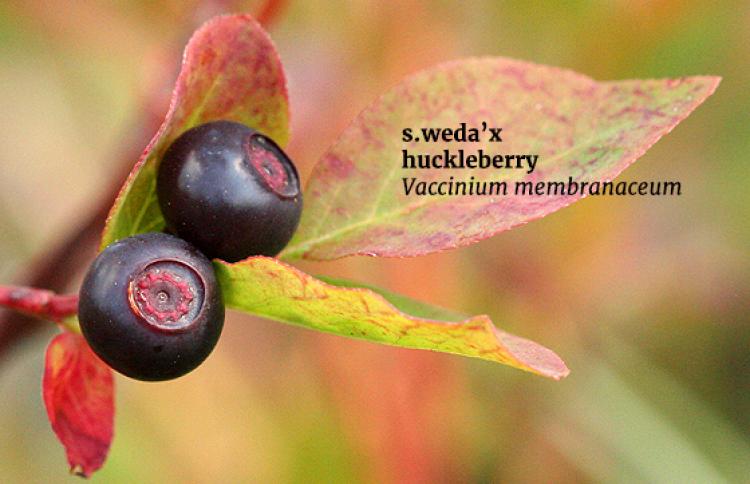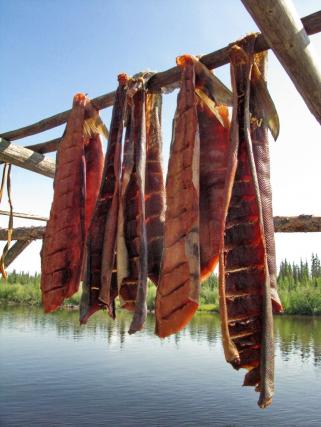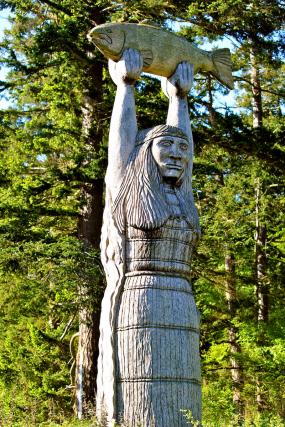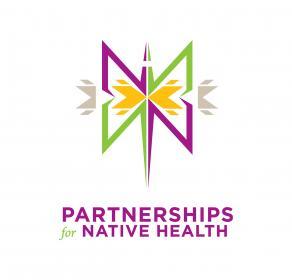By Meghan Jernigan (Choctaw Nation) and Genevieve Wanucha
As published in Dimensions Magazine - Fall 2019
Diverse, abundant, and nutrient-rich best characterize the traditional diets of the Coast Salish Tribes of the Pacific Northwest. Before contact with European populations in America, Native people in this region consumed almost 300 different species of plants, animals, fish and shellfish throughout the year. Harvesting in time with the seasons, people enjoyed and preserved nettle shoots, bracket fern root, bitterroot, cous root, soapberry, gooseberry, hazelnuts, acorns, dandelions, seaweeds, camas bulbs, many types of salmon, smelt, fowl, and game, along with a variety of other foods that are not easy to obtain today.
The movement of American settlers to the west rapidly altered ecosystems and restricted access to lands and waters, making it increasingly difficult for Coast Salish tribes to harvest and maintain traditional foods. From 1854 to 1856, seven treaties, including the Treaty of Point Elliott, established the reservation system for Washington tribes, limiting access to fishing and harvesting, and drastically altering the Coast Salish diet. By 1890, most tribes had been forced onto reservations, and government restrictions limited travel and food-centered cultural practices and celebrations. A diet largely comprised of milk, pork fat, sugar, beans, and wheat became the primary option.
This disruption of a nutrient-dense food system, and its effects compounded over generations, is reflected in the chronic health issues seen in American Indian communities today. Research has revealed high burdens of hypertension, type 2 diabetes, vascular brain injury, and stroke, all of which are risk factors for Alzheimer’s and related disorders.
For Native people, revitalizing Indigenous food systems is a public health priority, our roadmap for disease prevention and overall wellness. Food sovereignty is the inherent right for people to define their own food and food waste systems and the economic, social, and cultural practices that relate to the production and consumption of food. “It is the right for people to eat what they want to eat, and that right shapes your diet and that shapes the food system that you live within,” says Valerie Segrest, a member of the Muckleshoot Nation.
As the Director of Curriculum and Instruction for the Muckleshoot Tribe, Valerie Segrest is the leading voice in tribal food sovereignty. Her food systems work centers on traditional foods and plant medicines as critically woven into our overall health. She works as an educator and Native nutritionist, trained at Bastyr University. Through her tribal program and curriculum design, Valerie positions our link to the land with our legacy as tribal people.
On a busy Monday morning in a natural foods store in Federal Way, WA, Meghan Jernigan of Partnerships for Native Health and Genevieve Wanucha, both members of the UW ADRC outreach team, met with Valerie Segrest to learn about her approach to traditional foods and how to harness the power of food to improve health, longevity, and spirit.
Talk to us about how you grew up eating, and how you came to be passionate about food and diet. I’m a military child.
My father’s retired Navy and my mom is a retired government worker. They took me all over the world as a child. So, I grew up immersed in other cultures and food systems. And then I’d come home to my grandmother, and my job was to always set the table. I think now that’s what I do in life – try and figure out ways to set the table and make it beautiful. My mom also always made food really special, and I carry that on with my own children. Just yesterday, my 5-year old and I were walking through Pike’s Place Market, andit’s apple season. We were like, “The apples are ready, can you believe it?” It isn’t always traditional food, but anything local, fresh, healthy, vibrant, beautiful, available, and seasonal. This approach to food has always made sense to me.
Can you tell us about your background and how you approach your work?
My background is in traditional foods of the Pacific Northwest and food systems strategy, meaning how do we engage community in food and food systems work. And historically, our ancestors had strategies for how to manage a food system. It wasn’t just that we were gathering and hunting and fishing to take food, but we were tending to the land at the same time. And that process involved a lot of thought and planning and knowing seasonal changes and the environment. But as I engage with food, I take a step back and inspect the things that all of our food systems in this country have in common. What Native people are trying to do in restoring their food systems, what the Good Foods Movement is trying to do, and even what the USDA nutrition standards are set for—they’re all trying, in their own ways, to do the same thing: feed people really well. So, what are our commonalities? I like to live in that space.
How has the disruption in our foods systems impacted the health of Native people?
We hear a lot, ‘That happened 100 years ago. Get over it’. But what happened 100 years ago is our grandmothers gave birth to us. They had our mothers inside of them. One hundred years ago would have been close to Treaty times. The Civil War was just settling down. That’s a lot of stuff going on in our country. And I don’t think it’s just our stuff. But for Native people, it was a change that happened really fast that we weren’t asking for. And it was something imposed on us. Because of that, we have that genetic transmission of memory and knowledge through to several generations. Ultimately, colonization disconnected us from a food system that was incredibly nutrient dense. Coast Salish ancestors would have had double what the USDA recommends for calcium per day. We’re stuffed and starved because we’re eating heavy foods that are empty of nutrients. There’s extreme deficiency and then extreme excess of salt in one meal. We’re missing out on all these opportunities to increase our nutrition, as our ancestors would have naturally been doing. It’s just that we don’t have the resources. We’re seeing the lowest salmon runs ever. Herring and Ooligans don’t come back here. That’s our omega-3. That’s our Vitamin D. That’s our gut microbiome. This historical disruption is the root cause of all of these severe health disparities that we’re seeing related to inflammation, stress-related inflammation, and malnourishment: diabetes, cancer, and Alzheimer’s disease. Valerie, you have put forth traditional food principals of the native food sovereignty movement:
• Food is at the Center of Culture • Honor the Food Web • Eat with the Seasons • Eat a Variety of Foods • Traditional Foods are Whole Foods • Eat Local Foods • Wild and Organic Foods are Better for Health • Cook and Eat with Good Intention
Among those principles, what are the key principles that you think have relevance for people who are trying to reconnect with their traditional food? What principles stand out as the most important?
The traditional food principle that stands out as most important to me is: “Traditional Foods are Whole Foods.” For one example, you can have a cup of nettle tea and get your calcium supplement for the day. But, that’s not in the USDA food pyramid. Nettles also contain magnesium, phosphorus, and iron – all the things the body uses to manufacture blood. Your body doesn’t have to work hard to break the calcium apart because it is from a natural source, not chalk or animal product. All of the key principles hinge on each other. What’s the most important is to use intention every step of the way. Whether you’re harvesting from the land or walking around a grocery store, ask: How am I showing up to this? One of my teachers would always say, as you’re harvesting the plants, you should be talking to yourself, or out loud, or to the plant, about how you’re going to take its life, how you’re going to transform it, and how it’s going to be medicine. How beautiful and vibrant do you want it to look on the table? You have to be intentional about approaching the food with good thoughts, and also while you’re eating it and thinking about how your body responds. Am I feeling good? Does this make me feel good? Do I like the flavor of it? True, we have really busy lives and we have a lot going on. And we’re all suffering from chaos fatigue these days. We don’t need to also overburden ourselves with this pristine notion of a perfect diet. It’s too much. So, eat with good intentions and be grateful that you have it.
Thinking within the context of food sovereignty, we are interested in local tribal community efforts to develop agricultural economies and tailored approaches to clinical care. The WSU Partnerships for Native Health team recently visited the Puyallup Tribe’s Qwibil Natural Healing and Research Center, focused on cannabis use research. In partnership with WSU’s Michael McDonell (Director of Behavioral Health Innovations), they will evaluate whether medicinal cannabis reduces opioid use and pain and improves the physical and mental health of clients. What do you think about medical cannabis use for Native elders?
I think it’s a great place to move towards - acknowledging plant medicine as legitimate medicine. However, when you’re trying to diagnose something like gastritis, this roaming pain in the gut, it’s difficult to determine the cause. And taking a cannabis product or cannabidiol has the effect of blanketing the symptoms, and then we can’t sift through and locate problem. There are other plants that have cannabinoids them. It could also be a doorway into saying you could also use skullcap, or chamomile, or other plants that can do this particular thing very effectively, instead of this numbing for a condition where it’s hard to find the pain. But, I’ve seen it do miracles, and I’d rather people take that than opioids because I’ve seen a lot of elders lose their life in really terrible ways from opioids and I can’t imagine cannabis will have the same effect.
*
Despite the disruption of traditional food, medicinal, and environmental systems, Native communities remain strong, innovative, and determined. The Coast Salish people ate a heart and brain-healthy diet hundreds of years before modern medicine, and current research draws firm links between nutrient-dense greens, fish, and berries, and their protection against oxidative and inflammatory mechanisms and vascular heart disease. The most recommended foods for heart and brain health belong to certain classes of common foods, such leafy greens, berries, fish and seafood, olive oil, nuts and avocado. These foods form the basis of recommended approaches to healthy eating, such as the Mediterranean diet and DASH (Dietary Approaches to Stop Hypertension). In Feeding the People, Feeding the Spirit: Revitalizing Northwest Indian Food Culture, Valerie Segrest and Elise Krohn suggest ways to use easily found foods, which can offer the same texture and vitamins as the similar traditional food. For example, use blueberries for huckleberries, flax oil for Oolichan oil, green onion for wild onion, or grass-fed beef for venison. Valerie has given permission to share a few heart and brain healthy recipes from the Muckleshoot Nation. We hope you prepare them with good intention and enjoy with loved ones. •
Smoked Salmon, Cattail, Quinoa Salad
1 cup quinoa 2 cups water
2 Tablespoons olive oil
1 medium-sized onion 2 cloves garlic, minced
3 carrots, diced
1 cup chopped spring cattail shoots, peeled salmonberry sprouts, or leeks
2 Tablespoons chopped wild onion or ¼ cup chopped green onions
1 cup smoked salmon, cubed
1 Tablespoons lemon juice
Salt and pepper to taste
Add quinoa to boiling water, then turn to simmer and cover until cooked, about 15 minutes. Add olive oil to a pan on medium heat. Add onions, garlic, carrots, and saute until onions are translucent. Add cattails and green onions and saute until tender. Toss in salmon and lemon juice. Add salt and pepper to taste. Serve hot or chilled.
Vanessa’s Wild Berry Pemmican (A concentrated mix of fat and protein, a so-called ‘survival food’)
1 cup dried venison, elk, or beef jerky
1 cup dried wild berries (huckleberry or c.weda’x in Southern Puget Sound language), salal, blackcap raspberry, elderberry, salmonberry, service berry, soapberry, thimbleberry, wild blackberry, or wild strawberry)
1 cup raw hazelnuts, walnuts, sunflower seeds, almonds
1/3 cup nut butter With a knife, chop meat into very small pieces. Add dried berries, nuts, and nut butter. Blend well in a food processor. Store in a cool, dark place. This will keep for several months.
Recipes as pubished in Feeding the People, Feeding the Spirit: Revitalizing Northwest Indian Culture by Valerie Segrest and Elise Krohn









